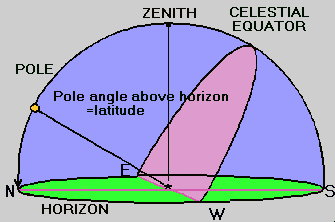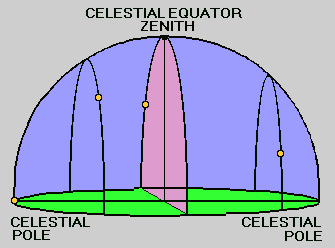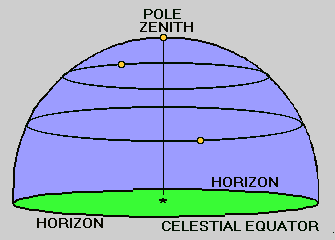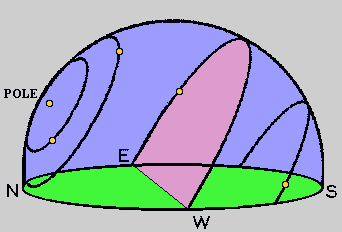THE APPARENT MOTIONS
Three basic apparent motions affect the entire celestial
sphere: rotation, revolution and precession.
APPARENT MOTION #1: ROTATION
The most obvious of these is the apparent daily rotation of the
celestial sphere. Once every 24 hours, the celestial sphere seems to pivot
on its axis, carrying everything with it, the sun, the moon, the planets
and the fixed stars (Today we know that this is the result of the rotation
of the Earth). The most fundamental effect of this motion is day and night.
It also provides us with a way of marking time here
on Earth. Thus, rotation is fundamental in our development of the concept
of time. One rotation marks the length of a day and night cycle. That has
always been obvious, but today's concept of smaller units such as hours,
minutes or seconds was much longer in coming.
Originally, following Egyptian practice, there were 24 hours in a
day, and the hour was 1/12th of a day, or 1/12th of a night. This hour
did not represent an absolute time unit as it does today. The Egyptian
hour was 1/12th of day or night, so, as the length of the day (or night)
changed with the seasons and the latitude, the length of the hour itself
was flexible. Even on any given day, day hours did not match the length
of night hours (excepting twice a year during an equinox).
The earliest clocks were sundials, and we have Egyptian examples
dating back to some 3500 years ago. But they only work during part of a
day, and only if the sun is shining. These problems led to a search for
a clock that would also work during hours when the sun did not shine. The
earliest successes with dividing the night into hours used water. Water
clocks were also Egyptian, and appeared some 500 years after sundials.
Sundials and waterclocks continued in use into the "dark ages" (and even
today, although mere curiosities of course) when they were joined by the
hourglass (using sand), supposedly invented by a French monk from Chartres
(of cathedral fame) in the VIIIth Century. Burning materials, from candles
to incense, were also used to subdivide time. Throughout history, all of
these examples were used to measure these ever changing hours.
It was not until the rise of the machine (the clock) that time was
organized into constant units. In a way, because machines could not adjust
the length of the hour, we turned to a day with 24 equal hours between
noon and the next noon, which happened around 1330. It took another nearly
350 years to add minutes and seconds.
Time and location
The sky appears to rotate 360 degrees in one day of 24 hours, carrying
with it the sun, the moon and the stars. That means that the sky rotates
15 degrees every hour or 1 degree/4 minutes. This also means that every
location on the planet has a different time, unless of course, locations
are aligned on the same meridian (north/south line). While this is no problem
on land where distances covered are small and travel between them is slow,
when travel becomes integrated and faster, and especially when travel is
over water, time and location become critically important. While the concept
is simple enough, it would require accurate clocks to allow longitude to
be figured out using time. This was not done until Harrison produced an
accurate sea-going clock in 1761. (By that time of course it had been known
that it was the earth that was rotating for some two centuries)
Motions of the objects in the sky
As I said above, the celestial sphere seems to pivot on its axis, carrying
everything with it, the sun, the moon, the planets and the fixed stars
once every 24 hours. It rotates around an axis which pierces the sphere
at the celestial poles. At right angles to this axis lies the celestial
equator. Depending on where we are, we see the motions of these stellar
objects in different ways. If we are standing at the North Pole, we see
all these objects traveling in circles around the North Celestial Pole,
with the North Star (nearly) at our zenith. This is called circumpolar
motion. If we are standing at the equator, the celestial equator
is at our zenith and the North Star is on the horizon, and all the objects
rise, transit and set. This is called equatorial motion.
Being neither at the equator nor at the north pole, most skies are mixed,
they exhibit both kinds of motion, with the objects surrounding the poles
showing circumpolar motion, while the rest follow an equatorial motion.
One consequence of this is that the latitude of any place here on Earth
is the same as the height of the axis of rotation above the horizon.
 |
Once every 24 hours, the celestial sphere appears to spin around
the earth, carrying everything with it. (Today we know the Earth rotates,
but that is not what we see). The first consequence of rotation is
that all celestial objects spin around an imaginary axis. This gives us
references, a way of locating ourselves in the sky. The rotational axis
defines the celestial poles. Running at right angles to axis of the poles
is the celestial equator that splits the celestial sphere into two hemispheres.
The celestial poles and equator also give us references here on the earth,
the poles, the equator and the cardinal directions, North, East, South
and West. |
 |
At the Earth's equator, the poles lie on the horizon and, as the
stars rotate, they rise above the horizon, cross the meridian (transit)
and set below the horizon. This is called equatorial motion. The
meridian is the line that runs from pole to pole passing through the zenith
and that splits the celestial sphere into two (east and west) halves, |
 |
At the North Pole of the Earth, the celestial Pole is directly overhead
and all objects rotate in circles around the poles. This is called circumpolar
motion |
 |
In all other places, skies are mixed. Stars follow both circumpolar
and equatorial paths. |





